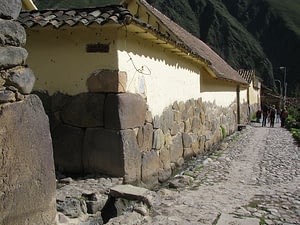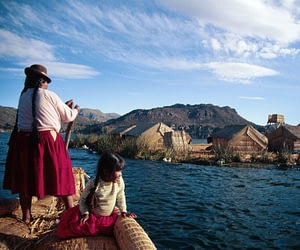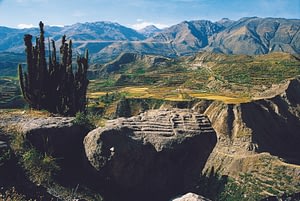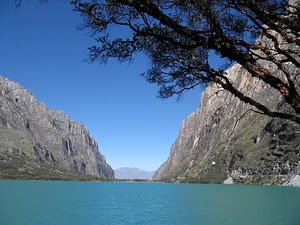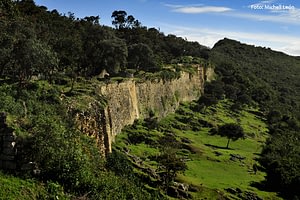Explore the highlights of Peru, from ancient trails to steamy rainforest. Read more below about our favourite places and things to discover during a trip to this incredible South American gem. When you're ready to plan your own adventure, packed with Peru highlights, you can choose from our suggested itineraries and combine with our responsible experiences for a memorable holiday with a positive impact to boot.
Recently voted one of the new Seven Wonders of the World, Machu Picchu is - rightly so - the most famous archaeological site in South America. 2011 marked 100 years since it was opened up to the outside world by Hiram Bingham in 1911. This Inca citadel is not only famous for its size and importance but also for its setting. Nestling high up in the Andes and perched on a precipice keeping a watchful eye on the Urubamba river, Machu Picchu inspires a sense of awe in all those who visit.
There are different ways to experience Machu Picchu, whether you trek there or get the train up the mountain. However, we do recommend you spend at least one night at the local town of Aguas Calientes. An overnight stay means you will have the morning after to take a second look around and the last thing we would want would be for you to return to Cusco, only to feel like you needed more time!
Cusco is often seen as a gateway to the famous archaeological site of Machu Picchu, yet it is a magnificent destination in itself. Cusco is located in southeastern Peru and on the eastern slope of the Andes. It is THE tourist destination par excellence and everyone who visits it is enchanted by the kindness of its people. But also by the imposing nature of its surrounding mountains, the warmth of its streets, and the history that still lives in each and every one of its corners.
Its cobblestone streets and the perfect fusion between colonial and Inca architecture will take you back in time. It will let you experience the ancient culture that still prevails in this corner of the world. It is not without good reason that Cusco was declared a UNESCO World Heritage Site!
Lake Titicaca is one of Peru’s most famous sights, a rare example of an attraction that is as much a natural highlight as a cultural one. At an altitude of 3,800m and straddling the border between Peru and Bolivia, Lake Titicaca is the highest navigable lake in the world. It has classic picture-postcard scenery with beautiful blue waters set against the snow covered mountains.
Lake Titicaca is not just one of Peru’s most famous tourist sights, the importance of the lake stretches back to the very foundations of the country. According to Peruvian mythology, Manco Capac and his wife Mama Ocllo emerged from Lake Titicaca before founding one of the world’s most famous empires - the Inca Empire – in around 1400 A.D. Lake Titicaca was also of importance to indigenous cultures such as the Pukara and Tiahuanacu before the time of the Incas.
Whilst its sheer beauty is certainly enough to merit a visit, the communities living around the lake and on its islands such as Uros, Sun and Moon, Taquile and Amantaní attract thousands of visitors every year. The strength of these communities and their dedication to their cultural heritage as well as their future survival has means that Puno hosts some of the best examples of community-based tourism in Peru.
Reached from Arequipa, the Colca Canyon has been carved out over time by the Colca River flowing from the high Andes down towards the Pacific ocean. Some reckon it to be the deepest canyon in the world and although far less famous, it is more than twice as deep as the Grand Canyon in the USA.
This breath-taking natural sight is not the only reason to visit the Colca Canyon. It is also one of the best sites from which to view the flight of Andean condors, among the largest birds in the world. As you gaze down on the canyon from the upper ridges, you will be able to see the condors seemingly floating at eye level on the rising thermals, offering a unique insight into their world.
The town of Huaraz is sometimes referred to as the ‘Switzerland of Peru’ and is probably best known as the tourist centre of the exceptionally beautiful Cordillera Blanca mountain range.
The Cordillera Blanca offer some of the most spectacular mountain scenery and activities to be found anywhere in the world. It is a region of immense beauty, remote valleys and unspoilt hiking trails. The area contains some serious mountains as well, such as Huascaran (6,768 m), the highest mountain in Peru, as well as archeological finds like the Guitarrero Cave, dating back to 10,000 BC.
We work with rural communities near the town of Humacchuco to offer you an insight into real Peruvian life (you can find out more under ‘experiences’). From there you can explore natural wonders which are still seldom visited by any tourist such as the Llanganuco Lakes, the beautiful Maria Josefa trail and the amazing views of Huaytapallana Valley. Whether you are looking for an authentic Peruvian experience, world-class hiking or time spent relaxing in the clean mountain air, this is the place for you.
Chachapoyas is highlight of the northern Andes, home to some of the continents best archaeological ruins as well as pretty colonial towns and cities. It is surprising that while Peru plays host to millions of tourists a year, this is still one of the least-visited areas in Peru.
For those interested in archaeology, it is a must visit area of Peru. Chachapoyas offers some of the most impressive pre-Columbian architecture anywhere in Latin America, with the fortress of Kuélap rivalling Machu Picchu in stature and natural setting. It is also adjacent to the Río Abiseo National Park, only one of 23 locations world-wide to be both a natural and UNESCO cultural heritage site.


